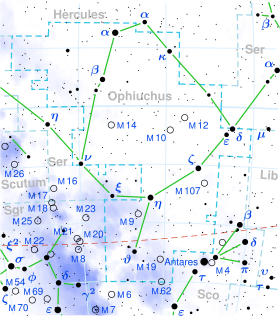Single star in the constellation Ophiuchus
φ Ophiuchi
Location of φ Ophiuchi (circled)
Observation dataEpoch J2000 Equinox J2000
Constellation
Ophiuchus
Right ascension 16h 31m 08.36732s [ 1]
Declination
−16° 36′ 45.8306″[ 1]
Apparent magnitude (V)4.27[ 2]
Characteristics
Spectral type
G8+IIIa[ 3]
U−B color index
+0.71[ 2]
B−V color index
+0.92[ 2]
Astrometry Radial velocity (Rv )−33.46[ 4] km/s Proper motion (μ) RA: −45.35[ 1] mas /yr Dec.: −37.34[ 1] mas /yr Parallax (π)13.39± 0.24 mas [ 1] Distance 244 ± 4 ly pc ) Absolute magnitude (MV )−0.08[ 5] Details[ 6] Mass ± 0.04M ☉ Radius ± 0.31R ☉ Luminosity ± 4.3L ☉ Surface gravity (log g )± 0.02cgs Temperature ± 32K Metallicity [Fe/H] ± 0.10dex Rotational velocity (v sin i )3.6[ 7] Age ± 10Myr Other designations φ Oph , 8 Ophiuchi , BD −16 4298GC 22200HD 148786HIP 80894HR 6147SAO 159963CCDM J16311-1636AWDS J16311-1637A[ 8] Database references SIMBAD data
Phi Ophiuchi , a name Latinized from φ Ophiuchi, is a single[ 9] star in the equatorial constellation of Ophiuchus .[ 8] apparent visual magnitude of 4.27.[ 2] light-years from the Sun based on parallax ,[ 1] radial velocity of −33.5 km/s.[ 4]
The stellar classification of Phi Opiuchi is G8+IIIa,[ 3] evolved giant star that has exhausted the supply of hydrogen at its core . In 2000, D. R. Alves identified it as a red clump giant on the horizontal branch that is generating energy by core helium fusion .[ 10] red-giant branch .[ 6] Bayesian estimates to arrive at a 94% chance the star is on the horizontal branch.[ 11]
The star is around 360[ 12] million years old with an estimated 3.16 times the mass of the Sun and 13.4 times the Sun's radius . It is radiating 112 times the luminosity of the Sun from its enlarged photosphere at an effective temperature of 5,131 K.[ 6]
It has two visual companions, component B, at magnitude 12.9 and separation 41.3", and component C, at magnitude 10.8 and separation 119.8".[ 13]
References
^ a b c d e f Van Leeuwen, F. (2007). "Validation of the new Hipparcos reduction". Astronomy and Astrophysics . 474 (2): 653– 664. arXiv :0708.1752 Bibcode :2007A&A...474..653V . doi :10.1051/0004-6361:20078357 . S2CID 18759600 . Vizier catalog entry ^ a b c d Ducati, J. R. (2002). "VizieR Online Data Catalog: Catalogue of Stellar Photometry in Johnson's 11-color system". CDS/ADC Collection of Electronic Catalogues . 2237 . Bibcode :2002yCat.2237....0D . ^ a b Keenan, Philip C.; McNeil, Raymond C. (1989). "The Perkins catalog of revised MK types for the cooler stars". Astrophysical Journal Supplement Series . 71 : 245. Bibcode :1989ApJS...71..245K . doi :10.1086/191373 . ^ a b Massarotti, Alessandro; et al. (2008). "Rotational and Radial Velocities for a Sample of 761 Hipparcos Giants and the Role of Binarity" . The Astronomical Journal . 135 (1): 209– 231. Bibcode :2008AJ....135..209M . doi :10.1088/0004-6256/135/1/209 S2CID 121883397 . ^ Anderson, E.; Francis, Ch. (2012). "XHIP: An extended hipparcos compilation". Astronomy Letters . 38 (5): 331. arXiv :1108.4971 Bibcode :2012AstL...38..331A . doi :10.1134/S1063773712050015 . S2CID 119257644 . Vizier catalog entry ^ a b c Reffert, Sabine; et al. (2015). "Precise radial velocities of giant stars". Astronomy & Astrophysics . 574 : A116. arXiv :1412.4634 Bibcode :2015A&A...574A.116R . doi :10.1051/0004-6361/201322360 . hdl :10722/215277 . S2CID 59334290 . Vizier catalog entry ^ De Medeiros, J. R.; et al. (2014). "A catalog of rotational and radial velocities for evolved stars". Astronomy & Astrophysics . 561 : A126. arXiv :1312.3474 Bibcode :2014A&A...561A.126D . doi :10.1051/0004-6361/201220762 . S2CID 54046583 . Vizier catalog entry ^ a b "phi Oph" . SIMBAD Centre de données astronomiques de Strasbourg . Retrieved 2021-01-24 .^ Eggleton, P. P.; Tokovinin, A. A. (September 2008). "A catalogue of multiplicity among bright stellar systems" . Monthly Notices of the Royal Astronomical Society 389 (2): 869– 879. arXiv :0806.2878 Bibcode :2008MNRAS.389..869E . doi :10.1111/j.1365-2966.2008.13596.x S2CID 14878976 . ^ Alves, David R. (August 2000), "K-Band Calibration of the Red Clump Luminosity", The Astrophysical Journal , 539 (2): 732– 741, arXiv :astro-ph/0003329 Bibcode :2000ApJ...539..732A , doi :10.1086/309278 , S2CID 16673121 ^ Stock, Stephan; et al. (August 2018), "Precise radial velocities of giant stars. X. Bayesian stellar parameters and evolutionary stages for 372 giant stars from the Lick planet search", Astronomy & Astrophysics , 616 : 15, arXiv :1805.04094 Bibcode :2018A&A...616A..33S , doi :10.1051/0004-6361/201833111 , S2CID 119361866 , A33 ^ Luck, R. Earle (2015). "Abundances in the Local Region. I. G and K Giants". Astronomical Journal . 150 (3). 88. arXiv :1507.01466 Bibcode :2015AJ....150...88L . doi :10.1088/0004-6256/150/3/88 . S2CID 118505114 . ^ Mason, Brian D.; et al. (2001). "The 2001 US Naval Observatory Double Star CD-ROM. I. The Washington Double Star Catalog" . The Astronomical Journal . 122 (6): 3466. Bibcode :2001AJ....122.3466M . doi :10.1086/323920 Vizier catalog entry














